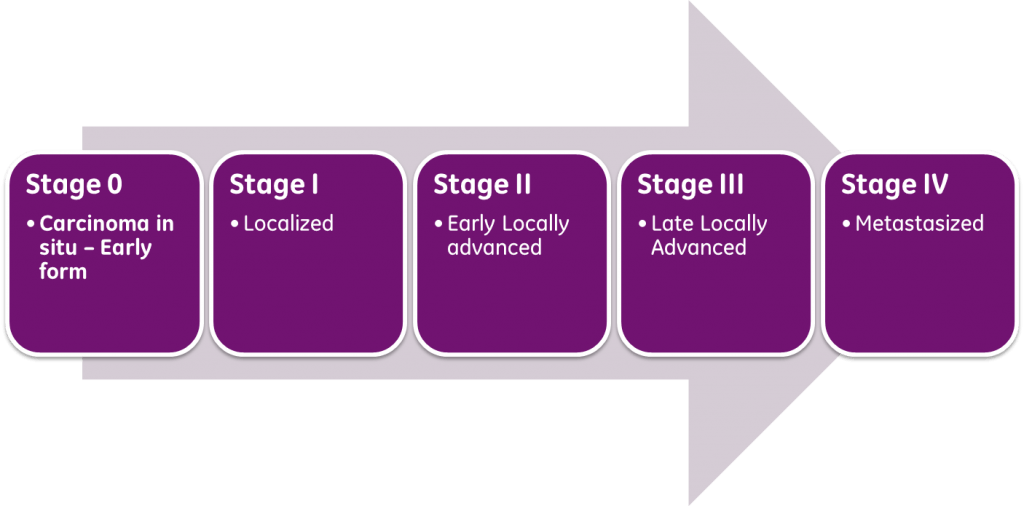
Read Bladder Cancer First.
- T0 ; No tumor in specimen collected
- Tis ; Carcinoma in situ ( CIS)
- Ta: Noninvasive papillary carcinoma
- T1: Tumor invades lamina propria
- T2: Tumor invades muscle
- T2a: Invades superficial muscularis propria
- T2b: Invades deep muscularis propria
- T3: Tumor invades perivesical tissue
- T3a: Microscopic perivesical fat invasion
- T3b: Macroscopic perivesical fat invasion (extravesical mass)
- T4
- T4a: Invades adjacent organs (uterus, ovaries, prostate stoma)
- T4b: Invades pelvic wall, abdominal wall
Invasive of nodal status:
- N0 No nodal involvement
- N1-3 Pelvic nodes
- N4 Nodes above bifurcation
- Nx Unknown
Invasive of metastatic status:
- M0 No distant metastases
- M1 Distant metastases
- Mx Unknown
Symptoms of bladder cancer
There is painless urination with bleeding( hematuria)
- Persistent blood in urine
- Frequency of passing urine
- Some patients will experience pain on passing urine ( dysuria)
- Lower abdominal pain
- Abdominal mass and swelling
- Lymphedema
- In severe cases, kidney failure as the cancer spreads to affect the kidneys
- Nausea and vomiting
- Metastatic spread to other sites such as the bones will cases pain at the affected regions
Diagnosing bladder cancer
The healthcare provider will perform a thorough medical history and examination in trying to find out how it started. You will be asked about the pain on passing urine, any change in color of urine, any frequency of passing urine and changes to it among others.
The healthcare provider will request for urine tests to rule out any infections such as TB, schistosoma cysts, and blood in urine
The definitive test for diagnosing bladder cancer is the Cystoscopy test. Most urologists will perform these diagnostic cystoscopies in an outpatient setting using a 16F flexible cystoscope and local Intraurethral lidocaine for topical anesthesia.
If a bladder neoplasm is detected, an outpatient transurethral resection (TUR) or biopsy is done with anesthesia.
Radiological tests such as intravenous pyelogram (IVP), retrograde pyelogram, or computed tomography (CT) or magnetic resonance (MR) urogram are used to identify additional tumors and obstruction of the upper urinary tract due to bladder cancer
Other tests done include the complete blood counts, blood indices, Fibrin Degradation Products (FDP) and bladder cancer tumor markers.
Treating Bladder cancer
There are several modes used in treating bladder cancer including, the use of drugs, radiotherapy or both. Most bladder cancers recur in the bladder, but can be managed with a combination of transurethral resection (TUR) and intravesical medications or immunotherapy. Here are some guidelines
- Bacillus Calmette-Guérin (BCG) vaccine is the most effective agent for treating high-grade superficial lesions. The use of this vaccine leads to reduction in progression rates and increases survival
- Radical cystectomy (removal of bladder) with diversion of urine bypassing the normal route is the most effective means to eliminate bladder cancer. Types of diversion include; orthotopic diversion with a neobladder.
- Radiation therapy in combination with TUR and a drug such as cisplatin, has been shown to be effective in preserving the bladder
- The use of medications using urinary catheters such as methotrexate, vinblastine, doxorubicin, and cisplatin, has shown high levels of toxicity with poor results.
- New drugs such as paclitaxel and gemcitabine are active, and combinations of these agents with platinum-based compounds have better results with less toxicity.
Why cystectomy (bladder resection) is done
- When there is a cancer within a bladder diverticulum
- In cases of primary, and muscle-invasive or high-grade tumors that allow complete excision with adequate surgical margins
- Patients in whom there is an inability to adequately remove tumor by TUR alone because of size or location
- When there is a tumor overlying a ureteral opening that may require ureteral reimplantation
- Patient refuses to have urinary diversion
- In poor-risk patients where diversion is not possible


